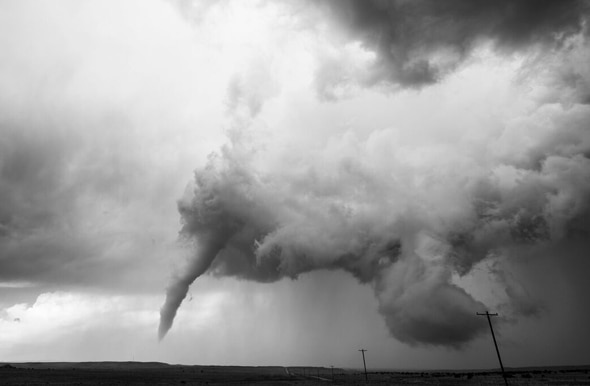Create a free profile to get unlimited access to exclusive videos, sweepstakes, and more!
Dramatic grayscale time-lapse cloud animation: Pulse

I do love a neck-hair-raising time-lapse animation of clouds gathering before and during a storm...but photographer Mike Olbinski takes this to the next step by, ironically, removing something: Color.
Watch his breath-taking video, “Pulse”, and make sure you’ve got it set to high resolution and full screen.
Holy. Wow. I love these kinds of storm animations, and Olbinksi has quite an eye for them (he has quite a few videos on Vimeo).
It’s funny how some things look better in grayscale than in color. It adds drama; perhaps the lack of color increases our sense of contrast. I’ve poked around to find an answer to this but, to be honest, I came up empty.
A supposition: We have two light receptors in our eyes: rods, which are good at detecting low light levels but are not color sensitive, and cones, which are used to detect colors but are not very light sensitive. Cones only work when there’s plenty of light so, as day turns to night, we rely more on our rods. That’s why only the brightest stars like Vega and Betelgeuse show color; most stars are too faint to trip our cones.
Anyway, at twilight and night our senses are heightened to danger, so perhaps seeing images in grayscale triggers that part of our brain. Again, this is pure speculation on my part. If anyone has a better answer, I’m listening. Leave a comment below!
And a note on the word “grayscale”. Most people say “black and white,” but that’s not technically accurate. If something were only black and white, you wouldn’t see any shades of gray! Grayscale literally means shades of gray, which is what you’re actually seeing.
The computer is taking numerical values and converting them to colors. In 8-bit images, 0 is black, 255 is white, and everything in between is a shade of gray, from dark to light (it’s called 8-bit because there are 28 = 256 shades). 16-bit has over 16,000 shades, and 24-bit over 16 million*. What some people call “true color” came into its own when monitors could use 24-bit pixels; it allowed for 8 bits each for shades of red, green, and blue. That can display more colors then the human eye can distinguish, so the monitor can faithfully display images in real color.
This gets interesting. Astronomers like to display things in grayscale, but with the shades reversed, so what’s really bright on the sky looks black in the image, and vice-versa. We see better contrast when something dark is against a bright background, versus the other way around, so displaying images this way lets us see details we might otherwise miss.
Colors help, too, because when astronomers take images of objects, we use filters to see specific colors of light. This is because different elements and molecules emit at different colors, and using these filters allows us to distinguish them. If you then map each filter to a displayed color, you can see where the corresponding material is in your object. For example, years ago I studied a ring of gas around a supernova and found that the hydrogen in the ring was primarily closer to the inside edge of the ring than oxygen; I could have figured this out by mathematically analyzing the ring (which I did), but also by simply taking the two images, giving them different colors, and displaying them on top of each other. The red hydrogen filter image clearly showed the ring as slightly smaller than the green oxygen image. Boom.
So, adding colors can help us analyze scientific data...and there are a zillion other tricks we can do as well. So, I find it rather funny that, by taking away the colors, Olbinski was able to add something to his storm video, or at least amplify it: The drama.
Perhaps colors might help me scientifically analyze his video —a green glow, for example, may indicate hail inside a mesocyclone. But even without color, the science of the storms is amazing, from the hydrodynamic flow of the clouds, the way the moisture feeds into the storms and is released by it, to how the vortices form to create tornadoes. All of these are irresistibly compelling as they are forbidding. The beauty and the science are intertwined!
Our eyes and brain combine into an astonishingly sophisticated system capable of both rational thought and emotional response. Together, they give us a lot more depth of appreciation for nature.
* If you’re curious, 50 shades of gray would be between 5 bits (32 shades) and 6 bits (64).


























